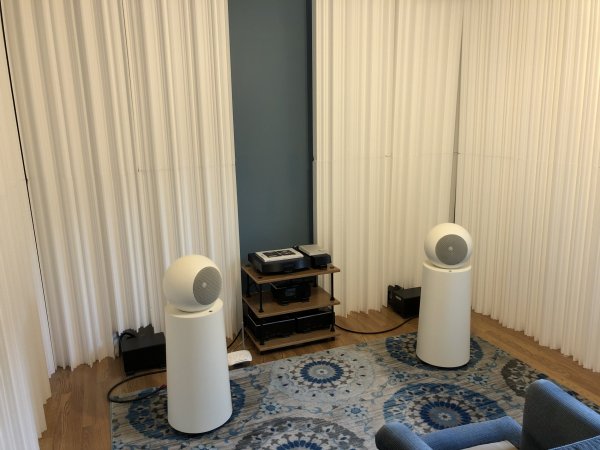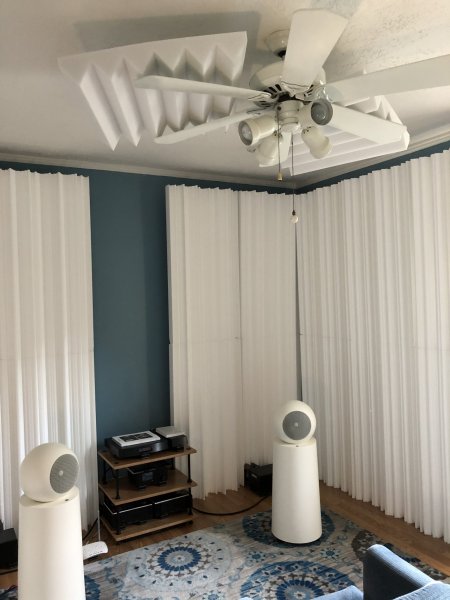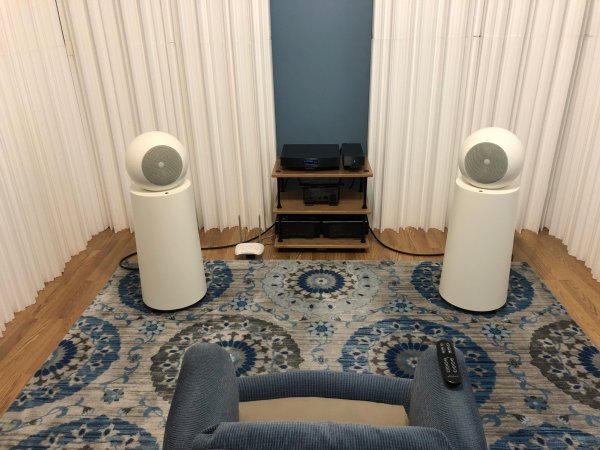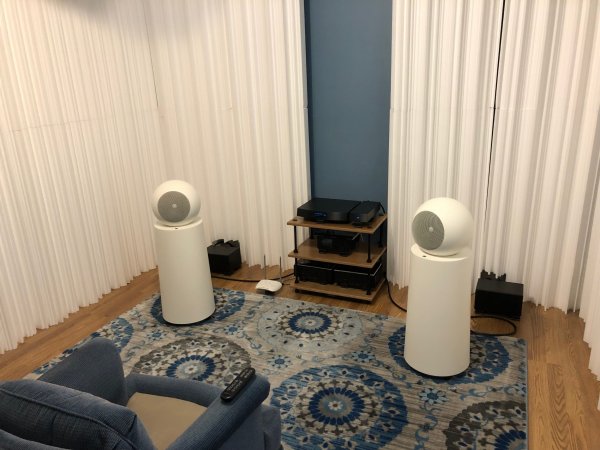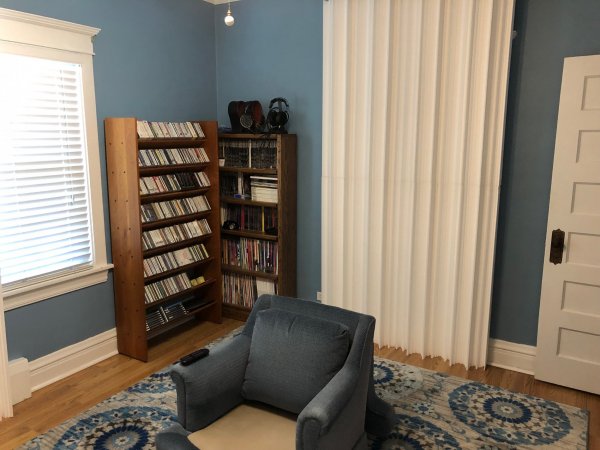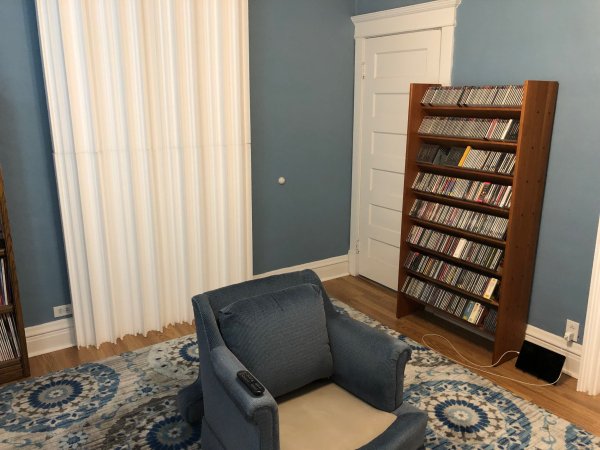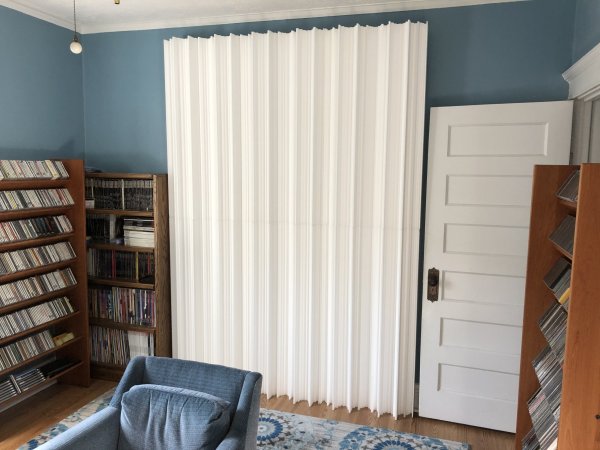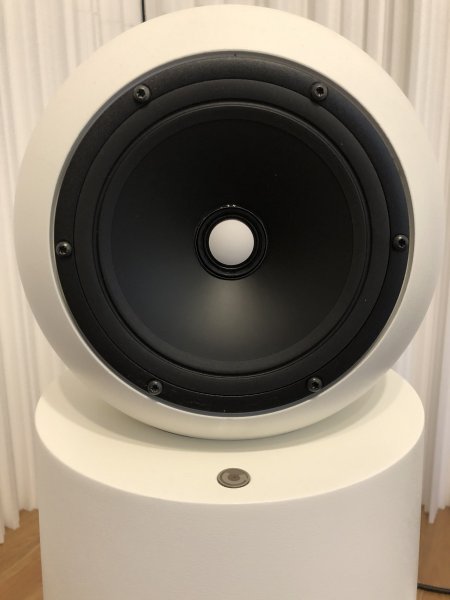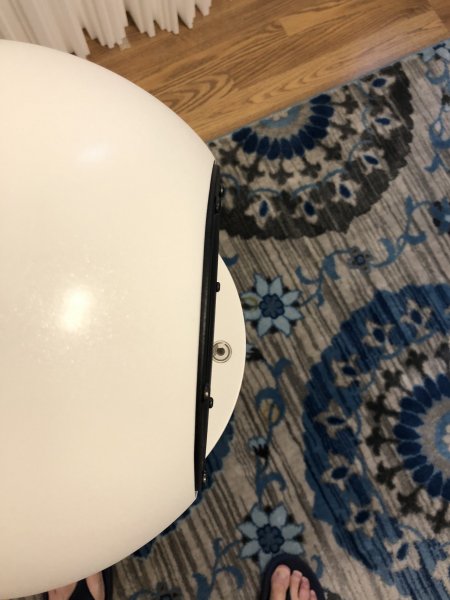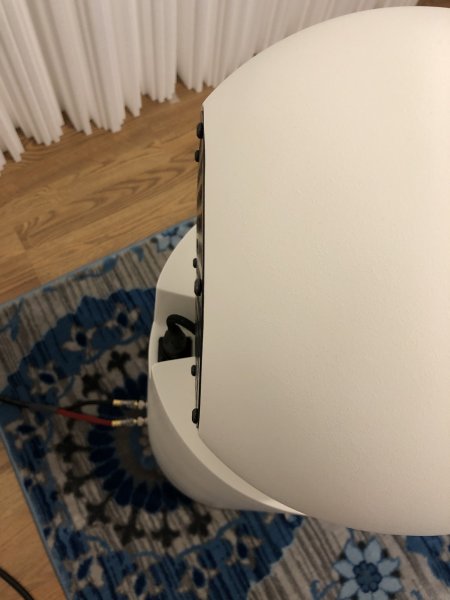Bottom Line at the Top
I'm now the proud owner of a pair of the Gradient 1.4 speakers in the all-white finish. I've had them in my listening room for a few weeks now. My bottom line so far is that, for my tastes, these are the best speakers I've yet owned, on balance as sonically pleasing and realistic as the Harbeth Monitor 40.2, while being much less expensive, physically a lot easier to manage, and even better for near-field listening in a small listening room like mine.
Why Would I Do This!?
Audiophilia
Yes, I admit it. I'm an audiophile first and a music lover second. So shoot me.
That's why I find fault with audio equipment so quickly and easily and seemingly change equipment almost as frequently as some people change socks. And it's not like equipment manufacturers or a magazine or website is paying me to do this. No, sir-ee, I spend my own hard-earned cash on this stuff. Yes, I sell what I move on from, but rarely recoup more than about half of what I originally spent since I'm more interested in quick sales to other audiophiles than in recouping that last 10 or 20 percent which I could by waiting a lot longer for that perfectly primed buyer to come along.
Sometimes, as has been the case recently, "the grass is always greener" syndrome gets so strong that I change things even when I don't hear any problems. A year and a half ago I wrote that "[t]he Harbeth Monitor 40.2 speakers are, for me, at least, end-game speakers. With these I can sail happily through my Golden Years. They have the sound of music as I've always dreamed it would sound at home."
To my ears, they still do. Then why did I move on? If there is any reasonableness to that decision at all, it goes something like this.
The Master Plan
Time to Declutter & Simplify
I love my wife dearly. Perhaps because of that it has taken me a few years to realize that she, unlike me but like most of her six siblings and father, likes to accumulate things (which she freely admits) and likes a high density of "stuff" in the house. I've recently realized that, perhaps in reaction to her default propensity, I've become increasingly concerned with decluttering and passing along things in the parts of the house over which I have the most control: my computer desk and audio room.
For my audio room, this translates to additional goals besides excellent reproduced sound quality. Despite the room's small size, I'm increasingly concerned that the equipment not dominate the room and that the room feel as open and spacious as possible. I'm also more concerned that I be able to easily move the equipment around a bit to experiment with other room set ups.
Further, I'm increasingly looking ahead to a time when, in a decade or so, we decide to move to another house, one with a single level, the type that older folks often need to continue to be able to navigate their home. While I'd still hope to have a dedicated audio room in any new home, finding the "right" space can be hit or miss, so it would be good to have speakers which can easily be made to sound excellent in most any room, even without the necessity of electronic equalization.
Time to Downsize My System
Yes, my Harbeth M40.2 speakers were still sounding as wonderful as ever. But I knew I needed to fix their ever-loosening binding posts. See this post in my M40.2 thread. The anticipation—much less the experience—of getting those large heavy speakers off their stands, turned upside down, opened up repaired and remounted on their stands, with the attendant need to then redo the fine details of the set up seemed daunting.
It occurred to me that with my new-found appreciation of headphone sound, I really just don't care enough about speaker-based audio at this advanced stage of my audio life to cope with, much less relish, such physical challenges. What I need are either lightweight stand-mounted speakers, or light-weight or at least easily movable, floor standers, something which I can move and adjust without fear of herniating myself or worse.
In a larger room, I suppose full-range electrostatic or planar magnetic panel speakers would be a possibility since such are usually quite light despite their size and are usually easy to move around. But in a small room, near-field listening is a necessity. Getting the sound from panels to cohere at short range is not always easy (or even possible with many such models) and coping with the back wave of panels is not fun either.
Making the Room Seem Larger
My listening room, at about 13' x 11' x 8.5', is rather small and while my big Harbeths, even without electronic equalization work extraordinarily well in the near-field way I listen to them in that room—better than most could ever imagine unless they've tried the M40 series from up close like that—they do seem a bit like gigantic headphones so positioned. It is easy to get a bit claustrophobic when continually exposed to a close encounter with such large speakers. Their large baffles' presence at 55 inches from my ears makes the room feel yet smaller than it actually is.
Room Brightening & Nightime Illumination Control
Despite the room being on the second floor and getting good light, it seemed a bit on the visually dark side with the rich blue paint, blue patterned oriental-style carpet, and numerous charcoal grey acoustic absorbers and diffusors. And then at night, I've had trouble getting the room lighting to be just a soft glow without visually distracting hot spots. Unlike in my prior basement room, for some reason in this room I haven't been able to get the two 4-watt night lights I use for semi-dark listening to be properly hidden to avoid bright spots.
To lighten/brighten the room, I could change all my acoustic treatment from charcoal gray to white. This would also allow the Gradient 1.4 speakers to better blend into the background. You see, the color version my wife REALLY liked the look of is the all-white version of the 1.4.
I really have liked the sound quality produced by the P.I. Audio AQD diffusers, which are quite inexpensive as such things go, very lightweight, and can stand on their own without being attached to the wall behind them, even when stacked one atop another to create an eight-foot tall wall of diffusers. I was using only one set of four charcoal gray AQD diffusers, combined with Sonex acoustical foam of the same color to treat the room acoustics. For my room, I could substitute six sets of four 2' x 4' AQD diffusers in white. That many diffusers would totally treat the speaker end of the room plus put an eight-foot by 4-foot array along the wall behind the listening position. As it turns out, the delivered price of those diffusers is only $1,320. If the room proved too live with no foam absorbers, white foam absorbers are available and I planned to replace the charcoal gray ones I have near the ceiling with white ones and would have six extra 2' x 2' white foam panels left from a minimum order of eight-to-a-box anyway.
Reducing Heat and Shortening the Equipment Rack
The electronics produce too much heat, both for the room and for their own good. This room tends to be the warmest in the house even without the audio equipment running. I want to keep the center-mounted five-shelf equipment rack low and thus down out of the way so as to minimally interfere with center imaging. But that meant putting a minimal amount of space between shelves. Those tight shelving arrangements make the equipment hard to get to—especially in back where most connections are—and keeps the equipment, which I leave turned on all the time for maximally stable and best sonics, running pretty hot.
The Harbeths, for very best sound, need some electronic equalization in this room, especially in the midbass. The best sounding/easiest to use EQ I've found is the DSPeaker Anti-Mode X4, but its internal processing limits the digital signal output to 96/24. It will not accept DSD input and won't output 24/192. I might be missing the last word in digital fidelity from some high-res files on Qobuz or other hi-res sources by running my sources through the X4. Now, most speakers need some such EQ to sound their very best in any room.
[Continued below]
I'm now the proud owner of a pair of the Gradient 1.4 speakers in the all-white finish. I've had them in my listening room for a few weeks now. My bottom line so far is that, for my tastes, these are the best speakers I've yet owned, on balance as sonically pleasing and realistic as the Harbeth Monitor 40.2, while being much less expensive, physically a lot easier to manage, and even better for near-field listening in a small listening room like mine.
Why Would I Do This!?
Audiophilia
Yes, I admit it. I'm an audiophile first and a music lover second. So shoot me.
That's why I find fault with audio equipment so quickly and easily and seemingly change equipment almost as frequently as some people change socks. And it's not like equipment manufacturers or a magazine or website is paying me to do this. No, sir-ee, I spend my own hard-earned cash on this stuff. Yes, I sell what I move on from, but rarely recoup more than about half of what I originally spent since I'm more interested in quick sales to other audiophiles than in recouping that last 10 or 20 percent which I could by waiting a lot longer for that perfectly primed buyer to come along.
Sometimes, as has been the case recently, "the grass is always greener" syndrome gets so strong that I change things even when I don't hear any problems. A year and a half ago I wrote that "[t]he Harbeth Monitor 40.2 speakers are, for me, at least, end-game speakers. With these I can sail happily through my Golden Years. They have the sound of music as I've always dreamed it would sound at home."
To my ears, they still do. Then why did I move on? If there is any reasonableness to that decision at all, it goes something like this.
The Master Plan
Time to Declutter & Simplify
I love my wife dearly. Perhaps because of that it has taken me a few years to realize that she, unlike me but like most of her six siblings and father, likes to accumulate things (which she freely admits) and likes a high density of "stuff" in the house. I've recently realized that, perhaps in reaction to her default propensity, I've become increasingly concerned with decluttering and passing along things in the parts of the house over which I have the most control: my computer desk and audio room.
For my audio room, this translates to additional goals besides excellent reproduced sound quality. Despite the room's small size, I'm increasingly concerned that the equipment not dominate the room and that the room feel as open and spacious as possible. I'm also more concerned that I be able to easily move the equipment around a bit to experiment with other room set ups.
Further, I'm increasingly looking ahead to a time when, in a decade or so, we decide to move to another house, one with a single level, the type that older folks often need to continue to be able to navigate their home. While I'd still hope to have a dedicated audio room in any new home, finding the "right" space can be hit or miss, so it would be good to have speakers which can easily be made to sound excellent in most any room, even without the necessity of electronic equalization.
Time to Downsize My System
Yes, my Harbeth M40.2 speakers were still sounding as wonderful as ever. But I knew I needed to fix their ever-loosening binding posts. See this post in my M40.2 thread. The anticipation—much less the experience—of getting those large heavy speakers off their stands, turned upside down, opened up repaired and remounted on their stands, with the attendant need to then redo the fine details of the set up seemed daunting.
It occurred to me that with my new-found appreciation of headphone sound, I really just don't care enough about speaker-based audio at this advanced stage of my audio life to cope with, much less relish, such physical challenges. What I need are either lightweight stand-mounted speakers, or light-weight or at least easily movable, floor standers, something which I can move and adjust without fear of herniating myself or worse.
In a larger room, I suppose full-range electrostatic or planar magnetic panel speakers would be a possibility since such are usually quite light despite their size and are usually easy to move around. But in a small room, near-field listening is a necessity. Getting the sound from panels to cohere at short range is not always easy (or even possible with many such models) and coping with the back wave of panels is not fun either.
Making the Room Seem Larger
My listening room, at about 13' x 11' x 8.5', is rather small and while my big Harbeths, even without electronic equalization work extraordinarily well in the near-field way I listen to them in that room—better than most could ever imagine unless they've tried the M40 series from up close like that—they do seem a bit like gigantic headphones so positioned. It is easy to get a bit claustrophobic when continually exposed to a close encounter with such large speakers. Their large baffles' presence at 55 inches from my ears makes the room feel yet smaller than it actually is.
Room Brightening & Nightime Illumination Control
Despite the room being on the second floor and getting good light, it seemed a bit on the visually dark side with the rich blue paint, blue patterned oriental-style carpet, and numerous charcoal grey acoustic absorbers and diffusors. And then at night, I've had trouble getting the room lighting to be just a soft glow without visually distracting hot spots. Unlike in my prior basement room, for some reason in this room I haven't been able to get the two 4-watt night lights I use for semi-dark listening to be properly hidden to avoid bright spots.
To lighten/brighten the room, I could change all my acoustic treatment from charcoal gray to white. This would also allow the Gradient 1.4 speakers to better blend into the background. You see, the color version my wife REALLY liked the look of is the all-white version of the 1.4.
I really have liked the sound quality produced by the P.I. Audio AQD diffusers, which are quite inexpensive as such things go, very lightweight, and can stand on their own without being attached to the wall behind them, even when stacked one atop another to create an eight-foot tall wall of diffusers. I was using only one set of four charcoal gray AQD diffusers, combined with Sonex acoustical foam of the same color to treat the room acoustics. For my room, I could substitute six sets of four 2' x 4' AQD diffusers in white. That many diffusers would totally treat the speaker end of the room plus put an eight-foot by 4-foot array along the wall behind the listening position. As it turns out, the delivered price of those diffusers is only $1,320. If the room proved too live with no foam absorbers, white foam absorbers are available and I planned to replace the charcoal gray ones I have near the ceiling with white ones and would have six extra 2' x 2' white foam panels left from a minimum order of eight-to-a-box anyway.
Reducing Heat and Shortening the Equipment Rack
The electronics produce too much heat, both for the room and for their own good. This room tends to be the warmest in the house even without the audio equipment running. I want to keep the center-mounted five-shelf equipment rack low and thus down out of the way so as to minimally interfere with center imaging. But that meant putting a minimal amount of space between shelves. Those tight shelving arrangements make the equipment hard to get to—especially in back where most connections are—and keeps the equipment, which I leave turned on all the time for maximally stable and best sonics, running pretty hot.
The Harbeths, for very best sound, need some electronic equalization in this room, especially in the midbass. The best sounding/easiest to use EQ I've found is the DSPeaker Anti-Mode X4, but its internal processing limits the digital signal output to 96/24. It will not accept DSD input and won't output 24/192. I might be missing the last word in digital fidelity from some high-res files on Qobuz or other hi-res sources by running my sources through the X4. Now, most speakers need some such EQ to sound their very best in any room.
[Continued below]


